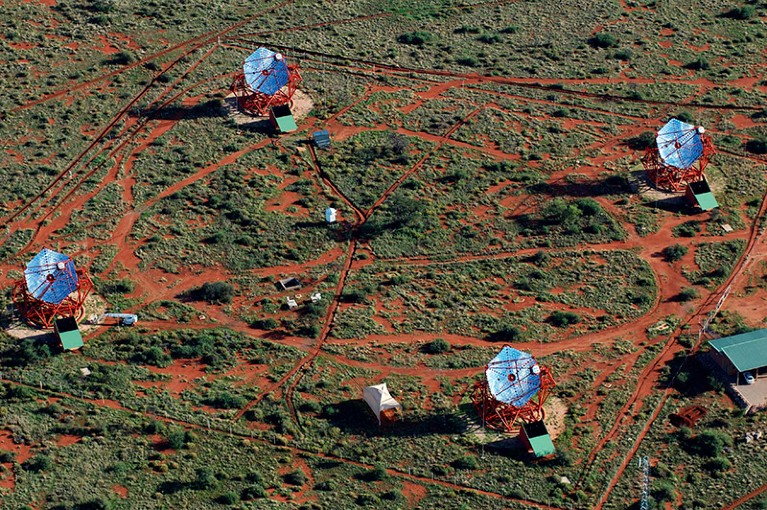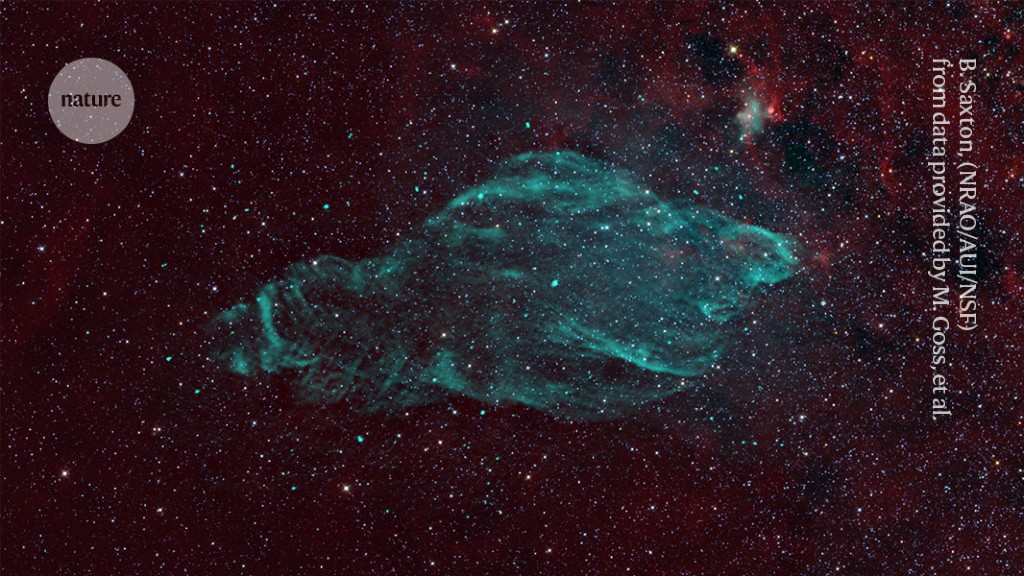An array of telescopes in Namibia has pinpointed the origin of some of the most energetic particles the Galaxy can produce. The observations point to a place where particles of matter spewed by a black hole in a region known as the Manatee Nebula are accelerated to near-light-speed.
The findings, published on 25 January in Science1 by researchers at the High Energy Stereoscopic System (HESS), are a step forward in the century-old quest to understand the origins of cosmic rays — fast-moving atomic nuclei and other particles that are continually hitting Earth’s upper atmosphere.
“For people like me who want to model astrophysical jets, including their internal composition, propagation and evolution”, the information produced by HESS is “incredible”, says Sera Markoff, a theoretical astrophysicist at the University of Amsterdam.
Rain from space
Cosmic rays can have a wide range of energies. The most abundant, lowest-energy cosmic rays consist of particles of solar wind that rain down on Earth’s atmosphere after spiralling in the planet’s magnetic field. Cosmic rays of much higher energies are thought to be produced by supernovae, the explosive deaths of massive stars. And yet-more-energetic cosmic rays originate outside the Galaxy, in particular from quasars — super-massive black holes that produce jets of plasma travelling at near-light-speed. These jets can have energies of up to 8 orders of magnitude higher than those produced in particle accelerators.
High-energy cosmic rays come from outside our Galaxy
Astrophysicists have proposed that plasma jets from black holes that are smaller than quasars — but still several times as massive as the Sun — could also contribute to the cosmic-ray population. The energies produced by these ‘microquasars’, which are also bright sources of X-rays and radio waves, could reach a range intermediate between those from supernovas and those from quasars.
In the latest study, astrophysicist Laura Olivera-Nieto at the Max Planck Institute for Nuclear Physics in Heidelberg, Germany, and her collaborators studied a microquasar called SS 433. The black hole lies in the Aquila Constellation at around 18,000 light years (5.5 kiloparsecs) from the Solar System, and forms a binary system together with a large star. Matter ejected from the star swirls around the black hole then spirals into it, generating highly energetic jets.
The binary system is surrounded by a nebula nicknamed the Manatee owing to its elongated shape. The nebula is a shell of dust and gas left over from a supernova between 10,000 and 100,000 years ago, during which the core of an exploding star collapsed to form the black hole. The outflow of matter from the supernova would itself have produced cosmic rays for thousands of years after the event, an activity that has long since quietened down. But some time between 10,000 and 30,000 years ago, the system lit up again, when the black hole formed its jets. The researchers think that this is when it started producing cosmic rays again.
Cosmic clues
Any cosmic-ray particles originating from a microquasar would move across the Galaxy in spirals before reaching Earth, their trajectories bent by magnetic fields. This makes it impossible to trace their paths back to a specific source. Instead, astrophysicists searching for the possible origins of cosmic rays look for γ-ray photons, which should be produced in the same processes that accelerate cosmic-ray particles, but travel to Earth in straight lines.
Astronomers first observed γ-rays from SS 433 in 2018 from the High Altitude Water Cherenkov (HAWC) observatory in Mexico’s Pico de Orizaba National Park2. But, unlike the team at HESS, they were unable to locate the exact source with precision.

The High Energy Stereoscopic System telescope array in Namibia’s Khomas highlands.Credit: Phillipe Plailly/Science Photo Library
Both HAWC and HESS detect γ-ray photons indirectly, but they use different approaches. When a γ-ray collides with an atomic nucleus in the upper atmosphere, it produces a shower of secondary particles, including electrons and their heavier siblings, muons. HAWC has water-filled tanks that pick up these particles as they reach the ground, whereas HESS works by imaging flashes of light that the particles produce as they move down the atmosphere. The five dishes of HESS can be pointed in a specific direction in the sky.

China’s mountain observatory begins hunt for origins of cosmic rays
This allowed HESS to precisely locate where in the Manatee Nebula the γ-rays were produced, and to focus on distinguishing those with particular energies. More than 200 hours of observations, made over 3 years, show that the γ-ray emission starts around half-way between the black hole and the supernova remnant, and slowly peters out. “The highest-energy photons only come from closer to the black hole,” says Olivera-Nieto. “This was really the crucial discovery.”
This suggests that the γ-rays — and by implication, cosmic rays — are produced by mechanisms internal to the jets, rather than by collisions with other matter, Olivera-Nieto explains. The space surrounding the black hole is otherwise empty, swept clean by the supernova’s expanding shockwave.
The finding “strengthens the case that X-ray binaries are smaller analogues to supermassive black holes, and equally capable of accelerating cosmic rays”, says Markoff, who praises Olivera-Nieto’s data analysis. “Her technique allowed the use of more data, and amplified the sensitivity enough to do this fantastic study, and so sets the stage for much more work like this.”

Dr. Thomas Hughes is a UK-based scientist and science communicator who makes complex topics accessible to readers. His articles explore breakthroughs in various scientific disciplines, from space exploration to cutting-edge research.








